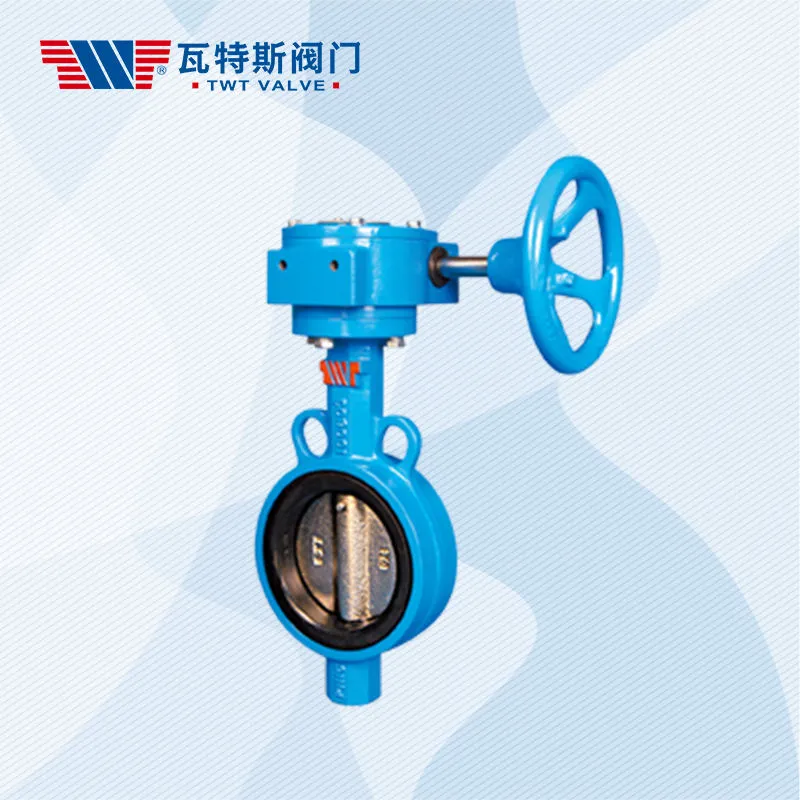TWT, a renowned wafer butterfly valve factory based in China, is recognized for its expertise in manufacturing high-quality butterfly valves. In this article, we will explore the world of butterfly valves, focusing specifically on the wafer butterfly valve and the flanged butterfly valve. As a leading provider of butterfly valves, TWT ensures precision engineering, durability, and reliable performance in their products. Join us as we uncover the features and differences between the wafer butterfly valve and the double flange butterfly valve, shedding light on their unique characteristics and applications.

Introduce About Wafer Butterfly Valves
A wafer butterfly valve is a versatile valve designed for regulating or isolating the flow of fluids in a piping system. It consists of a disc or plate that rotates on a central axis to control the flow, offering a tight shut-off when closed. Here are some key features and advantages of TWT’s wafer butterfly valve:
Compact Design: Wafer butterfly valves have a compact and lightweight design, making them suitable for installations where space is limited. The valve’s slim profile allows for easy integration into the pipeline, reducing installation and maintenance costs.
Easy Installation: Wafer butterfly valves are designed to fit between two flanges in the pipeline, with no additional bolts or nuts required. The valve is held in place by the flanges, providing a secure and leak-free connection.
Cost-Effective Solution: Wafer butterfly valves are often more cost-effective compared to their flanged counterparts, making them an ideal choice for applications where budget constraints are a consideration.
Efficient Flow Control: The streamlined disc design of the wafer butterfly valve ensures minimal flow restriction and pressure drop, resulting in efficient flow control and reduced energy consumption.
Double Flange Butterfly Valve Dimensions (ANSI):
- 2 inches: 8.5 inches x 8.5 inches
- 2.5 inches: 10.5 inches x 10.5 inches
- 3 inches: 12.5 inches x 12.5 inches
- 4 inches: 14.5 inches x 14.5 inches
- 5 inches: 16.5 inches x 16.5 inches
- 6 inches: 18.5 inches x 18.5 inches
- 8 inches: 22.5 inches x 22.5 inches
- 10 inches: 26.5 inches x 26.5 inches
- 12 inches: 30.5 inches x 30.5 inches
Understanding Flanged Butterfly Valves
A flanged butterfly valve, like the wafer butterfly valve, is used for regulating or isolating fluid flow. It features flanges on each side of the valve body, allowing for easy installation and removal from the pipeline. Here are some key features and advantages of TWT’s flanged butterfly valve:
Secure and Leak-Free Connection: Flanged butterfly valves provide a secure and leak-free connection between the valve and the pipeline. The flanges allow for easy installation using bolts and nuts, ensuring the integrity of the system.
Versatile Application: Flanged butterfly valves are suitable for a wide range of applications and industries, including oil and gas, water treatment, chemical processing, and HVAC systems. They can handle various fluids, such as water, gas, and chemicals.
Pressure and Temperature Ratings: Flanged butterfly valves are available in different pressure and temperature ratings, ensuring compatibility with the specific operating conditions of the system.
Flexibility in Maintenance: Flanged butterfly valves allow for easy removal and maintenance. By disconnecting the bolts and nuts, the valve can be taken out of the pipeline without disassembling the entire system.
Wafer vs Flanged Butterfly Valve
While both wafer butterfly valves and flanged butterfly valves serve similar purposes, they differ in their design and installation methods. Here are the key distinctions between the two:
Installation: Wafer butterfly valves are sandwiched between two flanges in the pipeline, with no additional bolts or nuts required. On the other hand, flanged butterfly valves are installed using bolts and nuts that connect the valve flanges to the pipeline flanges.
Cost: Wafer butterfly valves are often more cost-effective compared to flanged butterfly valves due to their simpler design and installation requirements. They offer a budget-friendly solution for applications where cost is a crucial factor.
Space Considerations: Wafer butterfly valves have a compact and lightweight design, making them suitable for installations where space is limited. Flanged butterfly valves, while versatile, require additional space for the installation of bolts and nuts.
TWT, a well-known China wafer butterfly valve factory, specializes in manufacturing high-quality butterfly valves, including wafer butterfly valves and flanged butterfly valves. Understanding the distinct features and differences between these valve types helps in selecting the most suitable option for specific application requirements. Contact TWT today to explore their range of butterfly valves and experience the performance and reliability they bring to your systems.